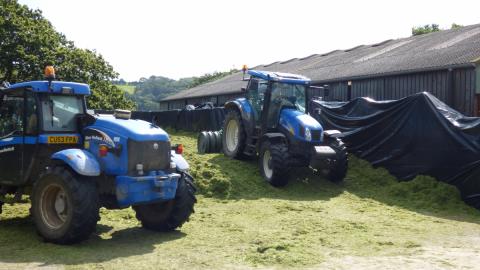By Dave Davies, Silage Solutions Ltd
This short article aims to highlight the things to look for when making your additive choice. As there are so many different products on the market it is impossible to detail each and every one.
The label must, by law, name each ingredient and quantity in the product. For example an inoculant with 3 bacteria must have the bacterial genus, species and strain identifier and how many in every gram of product. Likewise chemicals and enzymes must be named and quantified. This information enables you to calculate how much active ingredient you are applying for every ton of silage and thereby enabling you to compare products.
Additives can, more or less, be split into biological or chemical.
Chemical additives inhibit the growth of various undesirable microorganisms. For example, propionic acid, salts of benzoate and sorbate inhibit the growth of yeasts and moulds, whereas formic acid has activity against clostridia, and salts of nitrite inhibit clostridia and enterobacteria.
Biological additives contain different microorganisms applied either alone or in combination with enzymes.
The microorganisms are, almost always, lactic acid bacteria which can be divided into two groups.
Homo-fermentative - ferment sugars to lactic acid.
Hetero-fermentative - ferment sugar to a mix of lactic and acetic acid plus carbon dioxide (CO2) and water, they can also undertake a secondary fermentation converting lactic to acetic acid, CO2 and water.
Table 1 shows the bacterial species commonly used in silage additives and whether they are homo- or hetero-fermentative.
Table 1 Classification of Microorganisms
|
Homo-fermentative |
Hetero-fermentative |
|
|
Active ingredient/gram of forage
It is also important to calculate the level of active ingredient you are applying to every gram of forage. This does not have to be on the label but the information provided enables it to be calculated. Under UK conditions to improve grass/legume silage fermentation 1,000,000 homo-fermentative lactic acid bacteria for every gram are required. Likewise to improve aerobic stability a minimum of 100,000 hetero-fermentors per gram are required. So do the sums from the label and see if you have enough. Many products have a lower than adequate dose rate!
So which ingredients do YOU need?
For fermentation control in the clamp you need homo-fermentative bacteria or chemicals (formic acid/ nitrite salts to inhibit clostridia and enterobacteria). A rapid pH decline is required to inhibit both plant enzyme activity and undesirable microbial activity and leave more true protein and sugar in the silage for your livestock. Controlling the fermentation through the use of additives is always beneficial and if making the inoculant choice then the major component should be L.plantarum.
For aerobic spoilage/heating control at feed-out
Unlike controlling fermentation, good ensiling management can be 100% successful at controlling heating at feed-out, so improving management is the first action. If that consistently fails then an additive containing one or more of the following ingredients can help; sorbate, benzoate, propionate or hetero-fermentative bacteria.
And Finally
There are 44 L. plantarum strains listed for use by the EU, but just like your Welsh ewes or your Holstein cows, they are not all equal so be sure to ask the additive sales rep for their independent trial research on their additive. Whilst you all like testimonials from good farmers, and they are useful, those farmers haven’t compared their same grass ensiled under the same conditions, in the same season, with and without said additive.

